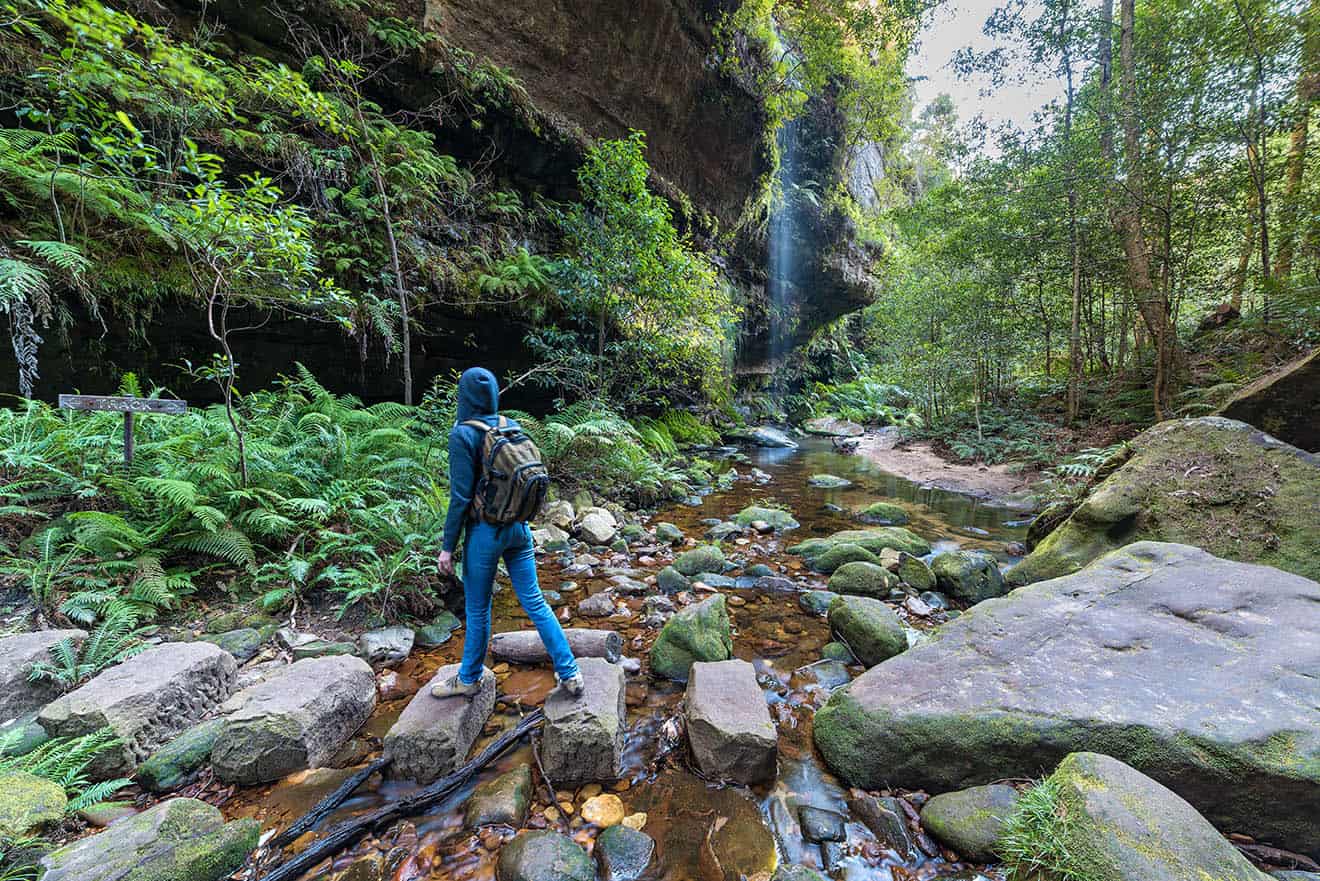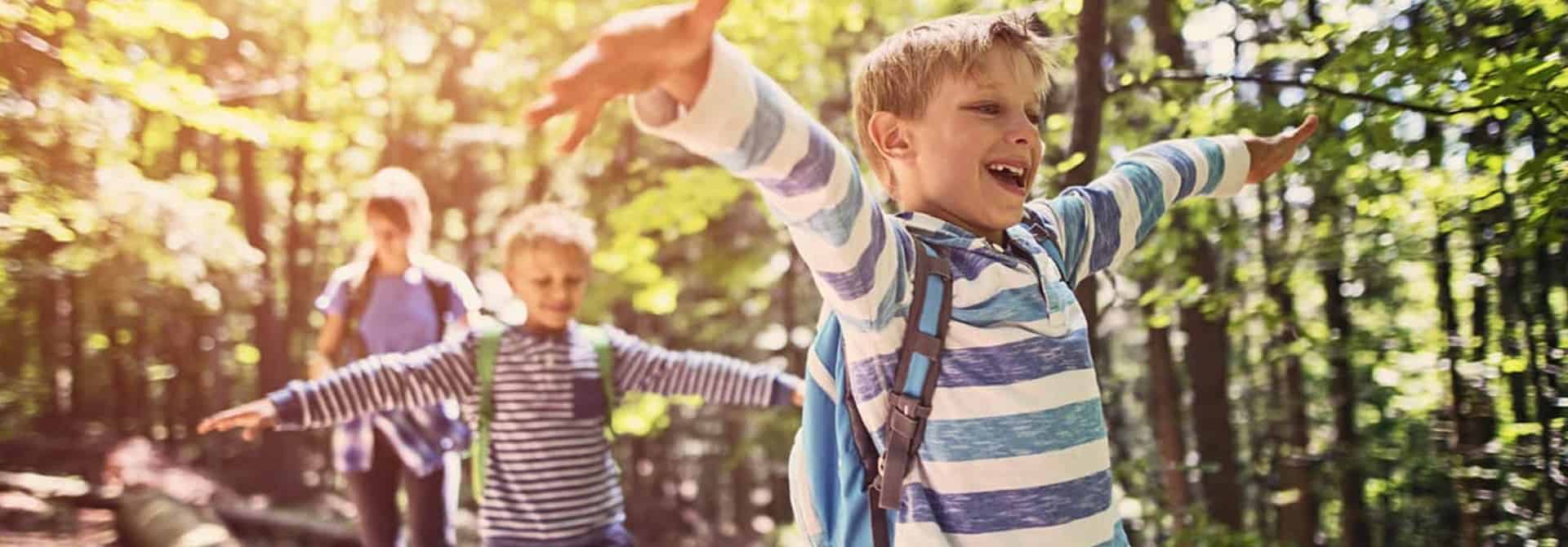A favourite pastime for many Australians, bushwalking combines fitness, education and adventure making. This leisure activity is a great day out for the entire family. As you would expect, there are certain levels or grades of bushwalks that can range an easy stroll, right through to being affiliated with extreme sports – the latter not being suitable for some family members!
Living where we do, in the serene World Heritage Blue Mountains, we’re lucky enough to have some of the best bushwalking tracks right in our backyard. Before we go through some of our favourite trails, let’s begin with the most important part of any bushwalk – planning.
What to wear, how to prepare and what to pack for a day out bushwalking
1. Shoes – this is by far the most important factor for a successful bushwalk. Thongs (or flip flops for our British and American friends), are a big no no. Not only are they slippery when walking over wet rocks or timber, they leave your toes open to a majority of harms including natural debris as well as nasty critters.
The above thinking also applies to any other sort of open shoe. Think closed, comfy and strong. A good pair of joggers, sneakers or sandshoes would be your best bet.
We’d suggest tying the laces in double knots too – especially for the kids. No one wants to trip over their laces, especially on uneven surfaces in the middle of the Aussie bush!
2. Dress – As us locals know; The Blue Mountains endures temperatures at both extremes of the thermometer (as well as everything in between)! Summers are often hot and dry in the day but can still dip much lower at night. Winters of course, can range from 10 degrees during the day to well below freezing on a clear night. Spring and Autumn? Well they can be anyone’s guess!
To plan for our ever-changing weather (and to keep your other items safe), wear a good quality backpack. This will come in handy to keep an array of items which you’ll see as we go through this list.
For clothing on a typical Summer’s day, we’d suggest knee length loose fitting shorts or lightweight pants with a comfy breathable t-shirt (such as cotton). On a standard Winter’s day, layer yourself with a t-shirt, jumper and parker or jacket. This will allow you to remove layers if you warm up substantially. You can pop a layer in your back pack and take it out again if it cools down. Also in the Winter, a beanie and some warm gloves will make your walk a much more comfy one, especially in the early morning or later in the afternoon.
Three further essentials to wear are a hat, sunglasses and sunscreen – especially in Summer, but still recommended in the Winter months. Pack a tube of sunscreen in your backpack and re-apply every few hours as needed.
Generally, we recommend you check the Bureau Of Meteorology www.bom.gov.au specifically the Central Tablelands forecast www.bom.gov.au/nsw/forecasts/centraltablelands for accurate weather and temperature conditions to plan your hike. We’d also suggest packing a water-resistant poncho for each of your walkers to keep dry from any showers that may come your way. Preparedness, although sometimes over cautious, can mean the difference between and great day out, or a day you’d rather forget.
3. Consumables – A must for every bushwalk is plenty of fresh water. Grab some bottles on your way at your local service station, or just fill a few up at home. You’ll never regret bringing too much water along. Even on a cold Winter’s day, it’s surprising how thirsty you can get bushwalking. Also, in the case of any unplanned hiccup or unexpected delay, water will keep you cool, calm and hydrated.
Food and snacks are imperative for any nature trail adventure. Keeping up energy levels is much easier with snacks. Many of us like to pack a full lunch for a stop along the way. Some freshly prepared sandwiches will go down a treat at your halfway point – and you’ll have plenty of water to wash them down with!
We can’t go past the ‘consumables section’ without a reminder to bring a small rubbish bag that you can put in your backpack. The Blue Mountains are a spectacular sight – so let’s keep them that way.
4. Phone – In this day and age, we probably don’t need to remind you to pack your fully charged mobile phone – more than one if you’re with others.
A smartphone is the modern-day Swiss-army knife. While it doesn’t contain a secret Philips head screw-driver, it does act as a torch, a communication link for any unforeseen circumstances (even in areas with no proper coverage, emergency services such as Triple 0 are still often available), a compass and downloadable maps.
One of our favourite uses for our smartphone is as a camera! There’s nothing better than looking back at your favourite happy snaps when you get home from your adventure. A portable phone charger is always a good idea just in-case as well.
Before you go, jump onto Google Play, the App Store or your Windows Phone Store and download the Emergency+ app. Emergency+ is an Australian Government initiative that takes advantage of the GPS capabilities of your smartphone and assists in contacting help if it’s ever needed. Better to be safe than sorry! For more information about the Australian Government’s Emergency+ app, click here.

Our favourite bushwalking tracks close to Springwood
1. Birdwood Gully – Springwood
Conveniently located near us here at Springwood Sports Club, Birdwood Gully is a 1 to 1 and a half hour round walk which is accessible via Bednal Road, Springwood.
Birdwood Gully is the easiest of our favourite walks and is suitable for the entire active family. While it has a medium grade descent, the track doesn’t travel alongside great drops or dangerous edges which makes it a family favourite. Descending into the gully reveals amazing vegetation and temperature changes revealing an astonishing rainforest canopy below – ripe for exploring and learning.
The round walk means that you can travel down or up either of the entrances on Bednal Road making for a slightly different walk depending on your entry point.
2. Blue Gum Swamp – Winmalee
Just down the road at the end of White Cross Road, Winmalee, you’ll find the Blue Gum Swamp Circuit Track. This trail is more difficult than Birdwood Gully, but still only rates as easy to medium. This trail can be walked or ridden by bicycle.
The Blue Gum Swamp Track is a 10km loop that takes you steadily climbing over 134 metres via Shaws Ridge, followed by a reasonably sharp decline leading you into the Blue Gum Swamp. Experienced hikers or cyclists can take a detour to Bees Nest and Grose Head South – it’s a sharp 1km ascent, rewarded with magnificent views over the Grose Valley.
Like most circuits, you can choose, to go clockwise or anti-clockwise, if you choose the latter, you’ll be greeted with a reasonably sharp climb back up to the carpark.
Make sure you allow a good 2 hours to walk this track.
3. Sassafras Gully Loop – Springwood
We’ve kept the biggest and most challenging track for last. It’s also the closest to the Club, which means you can join us for some well-earned refreshments when you’ve achieved this stunning circuit.
Give yourself 4 and a half hours to complete the Sassafras Gully Loop and be prepared to hurt a little afterwards with a total climb of 501 metres. This track is rated as hard, so it’s definitely not one for beginners on the bushwalking scene.
Start at the end of Sassafras Gully Road here in Springwood and head down into the wetness of the forest gully. You’ll be rewarded with spectacular rock formations and inspirational waterfalls.
As you pass Glenbrook Creek you’ll have the opportunity to rest at Perch Ponds which is also a fantastic camping area, perfect for an overnight stay on the trail.
Beginning the climb back up to the ridge, you’ll be stunned by Martins Falls, you can add another half hour to venture behind Martins Falls – well worthwhile if you have the extra time and stamina!
Almost back to the top of the ridge, you’ll pass Picnic Point. The perfect place to stop and take a much-needed rest before the last little climb to the end of the track. Here, you’ll be greeted with a picnic gazebo and view towards the houses at Springwood looking onto Magdala Creek.
After you’ve conquered the Sassafras Gully Loop, you’re more than welcome to pop into the Club for a bite to eat. Possibly even a little tipple – go on, you deserve it!
For more information about other local, Blue Mountain region and all New South Wales bushwalks, please visit www.wildwalks.com.
The team at Springwood Sports Club would also love to see some of your pictures that you take along the way. Jump onto our Facebook page at www.facebook.com/springwoodsports and upload some of your favourites.

